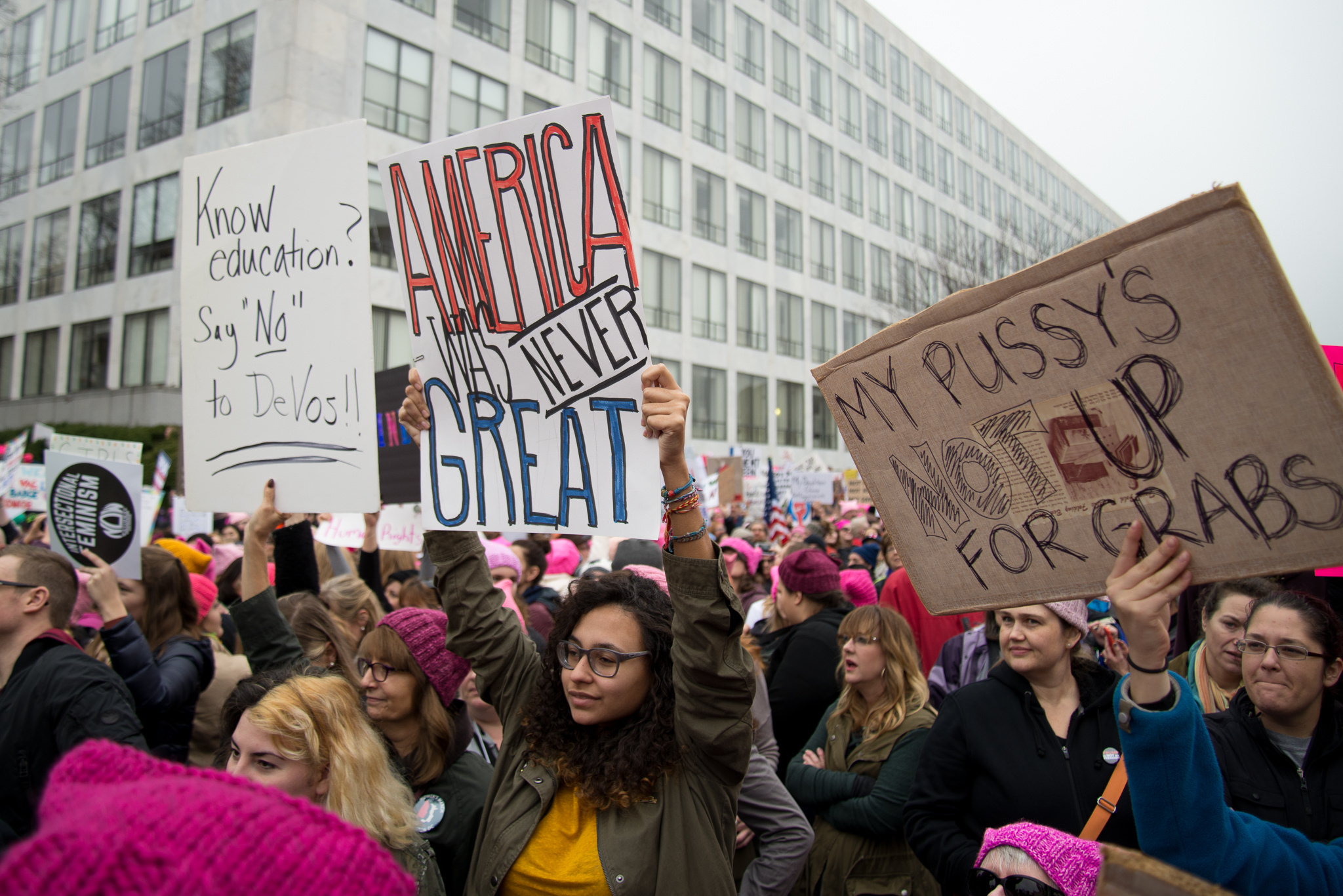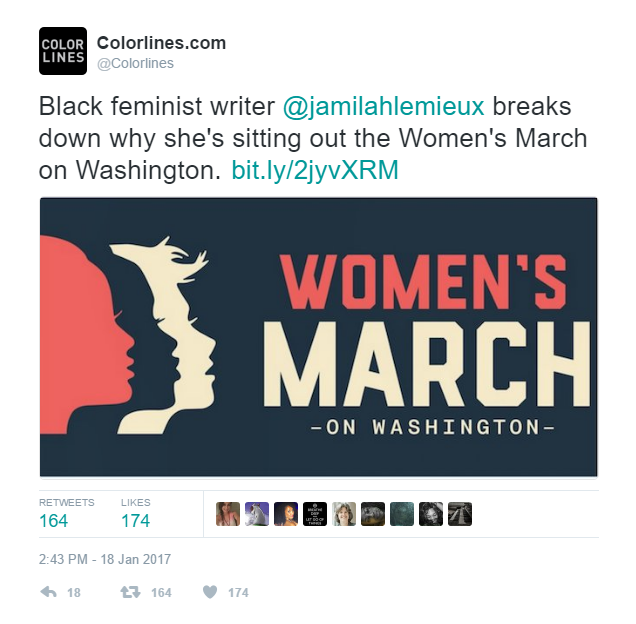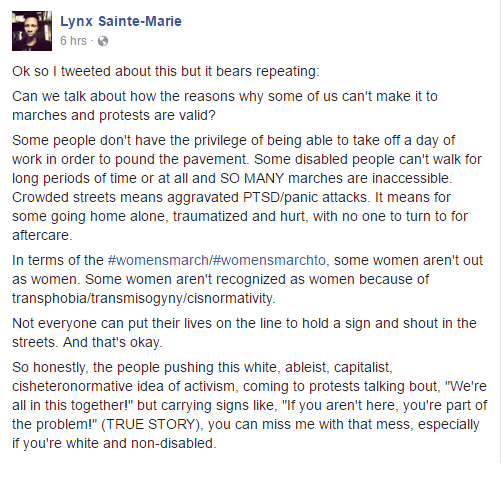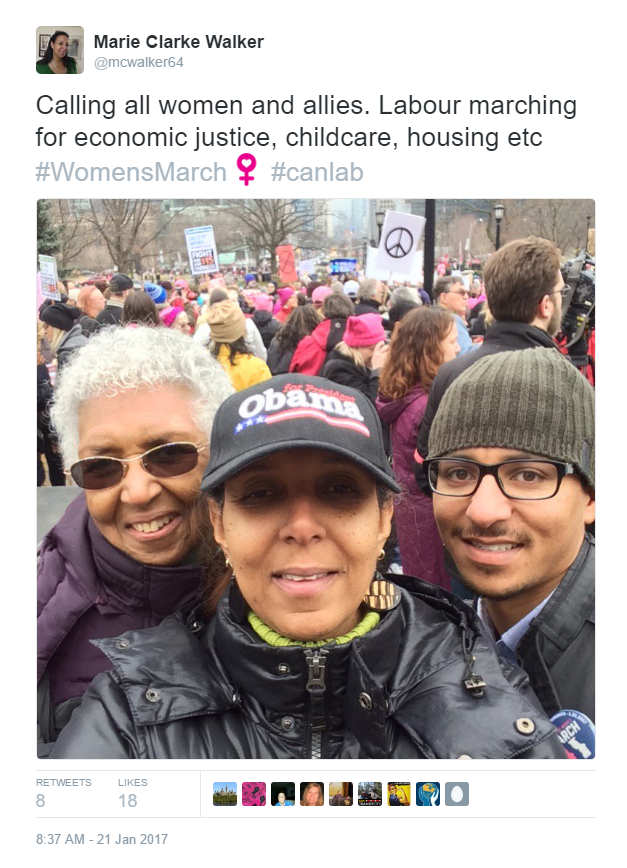Saturday’s Women’s March on Washington was livestreamed on Facebook by citizen journalists and major media alike.
If you logged into your social media platform of choice over the weekend you were likely to find photos, video and reflective posts — ranging from reinvigorated enthusiasm to cautious critique — all over your newsfeed.
Here are five types of broad perspectives on marching that we noticed on social media over the weekend. Each had something valuable to add to the ongoing public discourse on the nature of solidarity, Trump, inequality and organizing resistance.
1. PEOPLE WHO DIDN’T MARCH, BECAUSE.
As inspiring as the frantic knitting circles and airplane cabins full of protesters were, some of the sharpest analysis and most productive critique came from people who visibly and unapologetically chose not to march on Saturday. Reasons varied, but there was a powerful pattern of Black and racialized feminists resisting the expectation that they show up.
Jamilah Lemieux wrote a piece in Colorlines about her deliberate decision skip the march and how the move was connected to the “lack of sisterhood” that had already haunted her during the 2016 U.S. election season:
I’m not saying that I will never stand in solidarity with masses of White women under the umbrella of our gender, but it won’t be this weekend. Managing my depression is a complicated daily task, one that will certainly be exacerbated by the presidential inauguration festivities. It won’t serve my own mental health needs to put my body on the line (a body that I believe will invite more violence from Trump supporters than paler attendees) to feign solidarity with women who by and large didn’t have my back prior to November. Not yet. Eventually? Perhaps. But not now.
Those sentiments were shared by others, like poet, multimedium artist, activist and educator Lynx Sainte-Marie who brought attention to the range of reasons people may not (want to) take part in the protests.
And while many worked to make sure protesting could also happen online and from home through an organized virtual march, several folks brought attention to the exclusion of some women as a result of ableist views of what constitutes legitimate protest.
Adding to the critique were those who spoke openly on social media about the health and safety factors involved in participating and the challenges faced by loved ones who chose join local solidarity actions.
2. PEOPLE WHO MARCHED, BECAUSE ORGANIZING.
Community-based organizers, including union organizer and co-founder of Black Lives Matter,Alicia Garza used social media to put a deliberate focus on growing the base of people involved and active in change movements.
This perspective emphasized a vision of whole worker organizing that met people where they were at, analytical knowledge gaps and all.
3. PEOPLE WHO MARCHED, BECAUSE UNIONS.
Many of the marchers across Canada and the U.S. chose to engage policy issues through their unions. Labour leaders, including those at the Canadian Labour Congress, took part in the marches with an emphasis on labour solidarity.
4. PEOPLE WHO DIDN’T MARCH, BECAUSE WORK.
There was also a strong contingent of folks who used social media on the job to show that worklife, paying the bills and activism are messy and interconnected.
5. PEOPLE WHO DIDN’T MARCH, BECAUSE ENERGY.
Valuable insights were also added by people who protested the tokenizing and exceptionalism at play. They drew our attention to the elevation of one single day, over the many hundreds ahead of us.
Whether you marched or not, what matters is what we do next.
Ishani Weera is a labour educator and social media strategist for unions. She blogs about building social media solidarity at solidaritymedia.ca, where this article originally appeared.
Like this article? Please chip in to keep stories like these coming.
Image: Flickr/VeryBusyPeople










